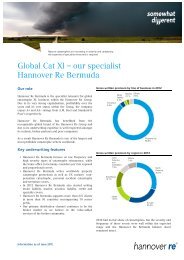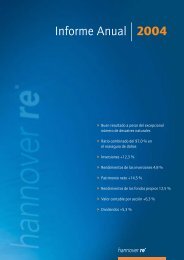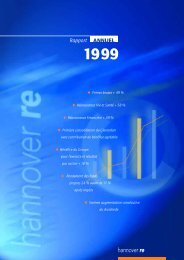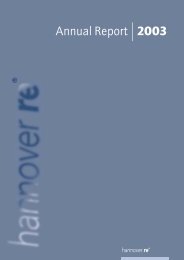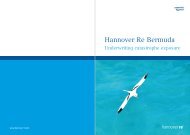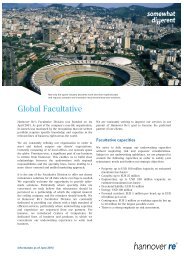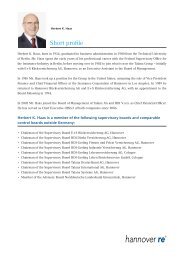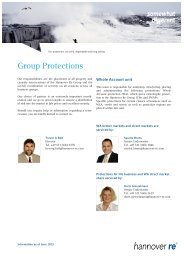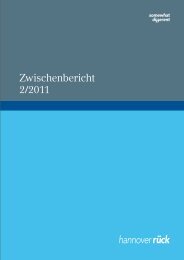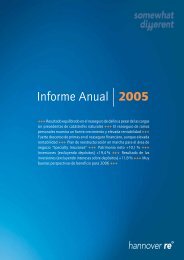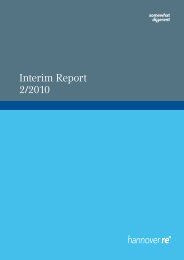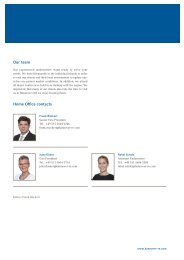Annual Report 2010 - Hannover Re
Annual Report 2010 - Hannover Re
Annual Report 2010 - Hannover Re
You also want an ePaper? Increase the reach of your titles
YUMPU automatically turns print PDFs into web optimized ePapers that Google loves.
The available economic capital grew by EUR 1,055.5 million<br />
from EUR 7,326.2 million to EUR 8,381.7 million in the course<br />
of the year under review. This was principally due to the rise in<br />
the IFRS shareholders’ equity. Our hybrid bond issued in the<br />
year under review also increased the available capital.<br />
Of special significance to our company is the overarching diversification<br />
between our business segments and lines. As a result,<br />
we are able to significantly reduce the total capital actually required.<br />
We define the cost of capital to be generated per business<br />
unit according to the capital required by our business segments<br />
and lines as well as their contribution to diversification.<br />
The indicators described above are further tools used to monitor<br />
and manage the risks associated with our business activities.<br />
Qualitative risk management methods<br />
<strong>Re</strong>gular quarterly reporting to the Risk Committee and Executive<br />
Board is supplemented as necessary by immediate internal<br />
reporting on material risks that emerge at short notice.<br />
Within our central system of limits and thresholds for the material<br />
risks of the <strong>Hannover</strong> <strong>Re</strong> Group, key ratios have been<br />
specified for steering and monitoring – within the meaning of<br />
the materiality concept defined in the risk strategy. Risk steering<br />
and monitoring is operationalised through the specification<br />
of suitable limits and thresholds for quantitatively measurable<br />
material risks. Material risks that cannot be quantified<br />
or are difficult to quantify (such as operational risks or reputational<br />
risks) are primarily steered and monitored using appropriate<br />
processes and practices (e.g. contingency and crisis<br />
communication plans).<br />
Internal control system<br />
Our qualitative methods and practices support our internal<br />
risk management and control system. The system is subject to<br />
a constant cycle of planning, action, control and improvement.<br />
The basic elements of the system, such as risk identification<br />
and risk reporting, are closely interlinked.<br />
Our mandatory practices, such as the Risk Management<br />
Framework Guideline, govern inter alia the handling of new<br />
products, monitoring of the risk-bearing capacity, risk reporting<br />
and risk responsibilities within <strong>Hannover</strong> <strong>Re</strong>’s overall system.<br />
Our risk reporting is geared to providing systematic and<br />
timely information about risks and their potential implications<br />
as well as ensuring adequate communication within the company<br />
about all material risks as a basis for decision-making.<br />
Another key element of the overall system is the Framework<br />
Guideline on the Internal Control System (ICS). The purpose<br />
of this set of rules is to ensure systematic execution of our<br />
corporate strategy with a special eye to capital protection. In<br />
accordance with these principles, the Framework Guideline<br />
puts in place a consistent understanding of controls as well as<br />
a uniform procedure and standards for implementation of the<br />
ICS across all organisational units of <strong>Hannover</strong> <strong>Re</strong>.<br />
The Framework Guideline defines concepts, stipulates responsibilities<br />
and provides a guide for the description of controls.<br />
In addition, it forms the basis for the accomplishment of internal<br />
objectives and the fulfilment of external requirements<br />
imposed on <strong>Hannover</strong> <strong>Re</strong>. The ICS consists of systematically<br />
structured organisational and technical measures and controls<br />
Diversification effect within the non-life reinsurance business group<br />
Risk capital per line of business for the 99.5% VaR in EUR million<br />
288<br />
3,515<br />
361<br />
66<br />
305<br />
272<br />
55.8%<br />
diversification<br />
787<br />
211<br />
202<br />
371<br />
1,554<br />
651<br />
North<br />
America<br />
Germany Marine Aviation Credit, surety & political risks<br />
Structured reinsurance products & ILS UK, London market<br />
& direct<br />
business<br />
Global treaty Global cat. XL<br />
Facultative<br />
business<br />
Total<br />
58 Management report opportunity and risk report<br />
<strong>Hannover</strong> <strong>Re</strong> Group annual report <strong>2010</strong>



